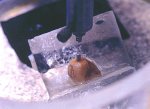|
For some
tissue engineered materials, it is essential to characterize
their mechanical properties. Cartilage for instance whether
natural or tissue-engineered is designed to be a structural
material. As such, its mechanical properties can be a
critical determination of how well it will perform.
Cartilage that differs in aggregate modulus from its
interfacing cartilage may promote osteoarthritis.
Alberts Biomechanics does
creep indentation tests based on the biphasic theory of
cartilage. With these tests, we can determine virtually all
of the viscoelastic properties of cartilage and of similar
tissue-engineered materials. A porous indentor made from
sintered steel is used for the indentation. The indentor is
designed to be more permeable than the tissue, so that only
the mechanical properties of the solid phase of the material
are measured.

From the creep indentation
curve and a measurement of the thickness of the tissue, we
can determine:
- The aggregate modulus:
The linear stress/strain relationship in a confined
compression test.
- The Poisson's ratio:
The negative of the ratio of the lateral strain to axial
strain due to an applied axial load.
Once the above two
constants are known, one can also determine the material's Young's
modulus and shear modulus.
The biphasic theory also
gives us the permeability of the tissue which
provides information on the tissue's viscoelastic or
timed-dependent properties.
We have a data base of the
viscoelastic properties of healthy and diseased human and
various species of animal cartilage at various sites in the
body. The measurements we obtained from your tissue can be
compared with those values.
If you work with tissue engineered
materials and need to characterize their mechanical
properties, please contact us.
|





